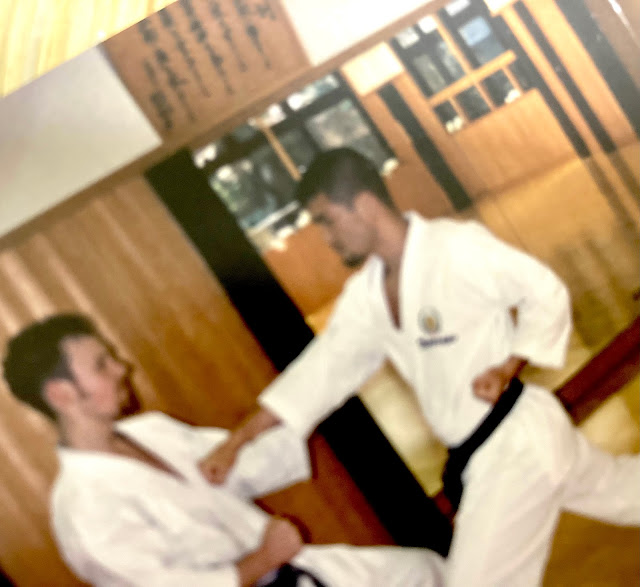 |
| Kumite training with World Games Champion, Inada Yasuhisa (photo, circa 2002). |
1. 上段 (Jodan): 上段追い突き (Jodan oi-zuki).
Target the jinchu with seiken. The maai is to reach between
two inches and midway through the skull. A deeper thrust is preferable, but not
at the expense of losing acceleration and engaging in mubobi.
2. 中段 (Chudan): 中段追い突き(Chudan
oi-zuki).
Target the suigetsu with seiken. The maai is to reach the
rear of the spinal column.
3. 前蹴り(Mae-geri): 中段前蹴り蹴上げ (Chudan mae-geri
keage).
Target the suigetsu or myojo with josokutei/koshi. The maai
is to reach the rear of the spinal column.
4. 横蹴込み (Yoko-kekomi): 中段横蹴り蹴込み (Chudan yoko-geri
kekomi).
Target the suigetsu or myojo with sokuto. The maai is to
reach the rear of the spinal column. Please note — Never land passively after
this waza; that is, after hiki-ashi land in zenkutsu-dachi as opposed
kiba-dachi.
5. 回し蹴り(Mawashi-geri): 中段またわ上段回し蹴り(Chudan or Jodan mawashi-geri).
Target the opposite side of the head or torso. Make sure your maai is close enough. Many people make
their mawashi-geri out of distance to deliver a full contact waza. Note — when
calling the attack announce “chudan mawashi-geri” or “jodan mawashi-geri”
depending on the waza you are executing.
Supplementary Notes —
a. If unsure about maai, use the ‘board breaking reference’. If the technique is not at the correct distance to break a board, i.e — only able to make surface level impact, quite simply, it’s wrong. Wrong because the technique is ineffective and literally grooving a bad habit. This bad habit is not negative only for the attacker… It also ‘wastes the defenders training time’.
b. Attack
with your zenkutsu-dachi. In the case of the tsukiwaza the seiken must impact
slightly before the completion of the stance; thereby, it maximizes hand speed
and maximum transfer of bodyweight/mass into the target. Obviously, in the
keriwaza one leg is already up; therefore, emphasize the snap/whipping action
of the kicking leg and the drive of the sasae-ashi. In both cases,”harmoniously
combine hard and soft actions”.
c. Always
keep in mind that whilst 基本
(Kihon) can be translated as ‘basic’, it better to be described as
‘foundational’ or ‘base’ techniques, drills and kata. This allows one to
properly characterize the term as understood by Japanese people. Needless to
say, most English speaking people instinctively perceive ‘basic’ as being
‘easy’ or for ‘beginners’, which is, of course, misleading.
d. Lastly,
always remember that correct form—which encompasses the above four points—is
the aim of Kihon Ippon Kumite (also 五本組手/Gohon
Kumite) as opposed to ‘fighting’. These drills are Kumite, but moreso ‘Kihon
with a partner’, which adds the elements of physical contact, timing and maai.
With these points strongly in mind one can make the most of these fundamental
partner drills.
To conclude, and to reiterate, “…please remember in Yakusoku
Kumite that the quality of the attack is of higher importance than the defense
and counterattack”. As, without an effective initial attack, the exercise is
completely invalidated; moreover, as I’ve already stated, ‘actually bad for
your karate’.
I hope that this article helps karateka to better practice their kihon ippon kumite and, in doing so, contribute to their overall budo development. 押忍! —AB
 |
| Countering using deai with jodan mawashi-geri. |
© Andre Bertel. Oita City, Japan (2023).
No comments:
Post a Comment
Note: only a member of this blog may post a comment.